I have written about art for 23 years, longer if you count reviews in my college’s paper. I have spent a lot of time with a lot of artworks, and I thought I was pretty good at looking at art. But there is a whole other level to looking, which is seeing a work’s arc from blank canvas (or paper) to finished product. For this, you have to know how the artist did it. This semester I took my first art class since high school, and my first serious art class ever. And I have started to see art differently. I have begun to understand the mark-making, to recognize the physicality of getting certain results out of certain materials. And I’m not exaggerating when I say it’s almost as if long-dead artists were making their works before my eyes.
This came about because, a few years ago, the artist Seth Alverson told me I should take a painting class. I think Seth was a little appalled by my lack of art instruction, and he told me that a painting class would probably not turn me into a painter, but it would definitely make me better at looking at paintings. Which would make me a better art critic.
Prodded by Seth, I called the artist Francesca Fuchs, the head of painting at the Glassell School at the MFAH here in Houston. Francesca agreed that an art class would be good for me, but she said I couldn’t take painting until I took drawing.
Drawing: of course! I hear it’s fallen on hard times in some art schools, taught unsystematically by grad students who themselves were taught unsystematically by grad students. But all the artists I really respect take drawing seriously, regardless of the kind of work they make (even those who work with computers or do performance art). My late husband, the artist Michael Galbreth, said, “Drawing is an anchor, not a crutch.” I think he was responding to a dismissive attitude of some artists enamored with new technologies and convinced by the 20th-century idea that the artist’s “hand” no longer matters. But drawing is an anchor. It’s every cave painting, every great old painter mapping out their masterpieces, every sculptor envisioning a work, every installation artist conceptualizing the volume of a space, and yes, even every Photoshop artwork, as David Hockney’s surprisingly good iPad drawings show us (though ironically they must be seen in person, printed out, to be appreciated — I don’t think they work as well on a screen).
Drawing is understanding at the deepest level how everything looks, moment by moment. The world, to the eye, to the hand, to the paper — an unspeakably difficult and, done well, miraculous translation. As long as humans are still physical beings and not yet thought-clouds floating around the universe, drawing will matter.
This is how I ended up taking Drawing 1 this semester at Glassell. My instructor was Michael Bise, an artist who exclusively makes very good drawings. Michael is the kind of instructor you want: he knows his stuff and he’s not going to hold your hand, but he will be kind if he sees sincere effort, and will reward it with encouragement and detailed notes. He’s the kind of teacher you want to do well for, even when your (my) lack of raw talent is plainly evident.
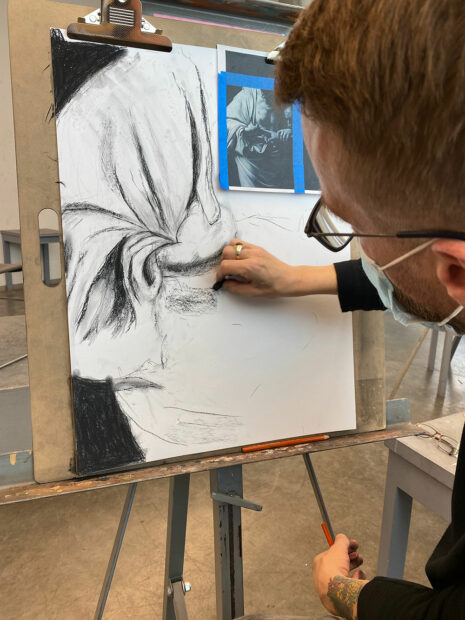
Michael Bise giving a demo in drawing class
In Beginning Drawing we learned the basics: contour (the outline of shapes), negative space, shading, perspective. We mostly used graphite and charcoal, though we dabbled in ink one day. We had a couple of life drawing sessions (one male, one female), which is fun and funny and oddly sexless — you get over the novelty of looking at a live naked human quickly when you’re struggling to get the hands right. So far I’ve made one drawing that’s OK, although nothing I’d get excited about if I were to see it in a gallery. Much more importantly, I have experienced sinking into a drawing — losing sense of time as a desire to capture the world realistically takes over, concentrating on the mark-making to get it just right. And being humbled by the lackluster results of my efforts.
This semester I had the opportunity to test whether I’d gotten better at looking when the MFAH opened its new Kinder Building, which houses its permanent modern and contemporary collections. In the works on paper gallery, I was struck by this remarkable charcoal drawing from 1940 by Grant Wood, titled March:
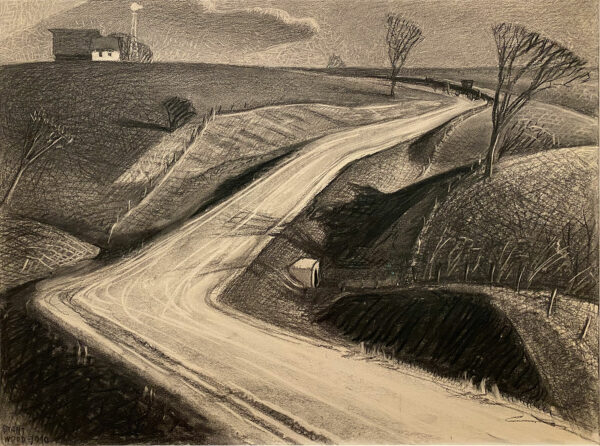
Grant Wood, March, 1940, charcoal on wove paper
I first saw the drawing before the class started, and I’ve been back since several times to look at it more. I initially admired it because it’s vigorous and confident and such a great composition — that road! Those hills! It wasn’t until about halfway through the semester that I suddenly recognized the little bush next to the fence for the mere squiggle it is. It’s just a doo-dad! How long did it take Wood to place that bush — one second? Two at the most? And yet, despite its economy, it reads.
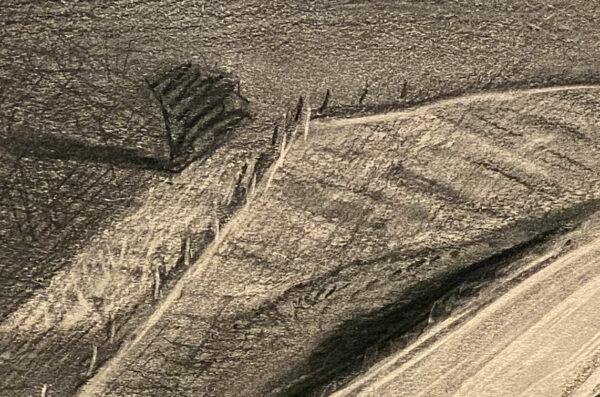
Before taking the class, I wouldn’t have consciously recognized that Wood made the dramatic, angular road by erasing over a ground of light color—those are the white stripes, which are energy and movement, as well as the sense of an uneven, rutted surface.
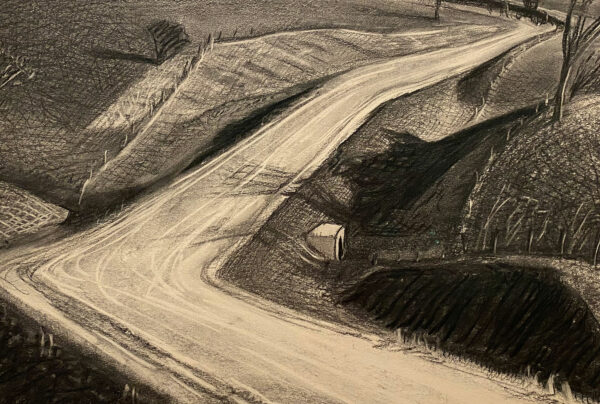
One of my favorite moments is the tree shadow that falls over the road. I love how Wood put down the pieces of it — darker lines on the right that bend up at the tips, indicating a raised edge in the road, and the lighter, brushier lines of shadow across the road itself, which Wood has erased through to reinforce the sense of the road’s texture.
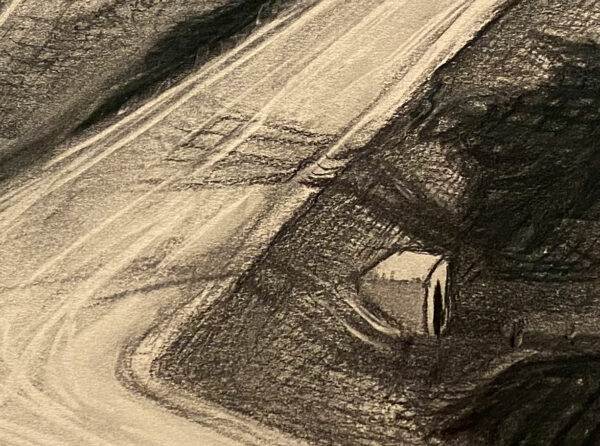
The eraser does the heavy lifting again in the lower right, with the tufts of weeds to the side of the road:

Finally, the technically brilliant shading of the hills is offset by the energetic hatch marks, some of which are drawn in, and some erased. Those hatch marks are critical. They give the drawing interest, they indicate that this is stylized and not meant to be an exact replica of nature, and they also keep things from getting too sappy (which a picture of a country road disappearing into a landscape could easily do):
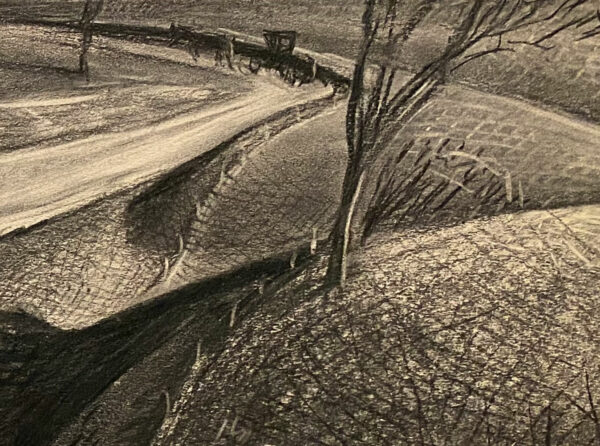
All these gestures, these simple marks that you can learn in a beginner drawing class, combine to tell us everything we need to know. They form a cohesive image when you step back and look at the whole (which Bise encouraged us to do, often, at our easels in class). But even though Wood’s techniques have been somewhat demystified for me, I am every bit as impressed as I was before the class — even more so, because I recognize the deeper mystery of the drawing’s power, brought forth by the artist’s skillful use of those basic techniques.
And though I said I wanted to get better at looking, my appreciation for March has moved beyond the visual and become something physical. I have a bodily appreciation for this artwork, for having lifted my own arm to paper, for having dirtied my own fingertips and the edge of my own hand rubbing charcoal, trying to make something that looked like something. It is so hard to do what Wood does here, on this one modestly scaled drawing in a gallery packed with them, in a building stuffed with great works of art, in a city and a state and a world spilling over with them.
And now all I want to do is keep looking.



32 comments
I also feel that this is one of your best pieces of writing. 🙂
Let me suggest another step…make your own charcoal, your inks, your conte crayons, your paper, your pastels, grind your pigments, and see where these efforts take you on your middle-age awakening of techniques, materials and processes for creating illusions or, as you say, “translating… and capturing the world realistically”. They may surprise you just as much…there’s always much to learn.
Kudos! I want to see your drawings. 🙂 great piece.
Your thoughtful article gives me hope that there might be a resurgence of appreciation for the magic and meaning possible in traditional techniques and materials. The work embodies its meaning and moves you there without need of wall text. Someone quipped recently that she was the only artist she knew who still bought her supplies at the art store! 🙂
This is wonderful writing and a memorable piece, so smart and insightful. Saving and sharing!
Keep going! Take more classes! How wonderful that you did that.
Kudos to you for doing this!
Personally, I am always a bit suspicious of arts writers and curators who have never made any art. Who are they to judge me? It’s like expecting someone who has never even held a screw driver to be able to tell me how to fix my car.
Old saying: You don’t have to be a chicken to know a rotten a egg.
Note: Art writers and curators aren’t trying to tell you how to fix your car (metaphorically, how to make art). They’re judging your art–something that viewers do, in writing or not, all the time.
Note: Betcha when the judgment is along the lines of, “Hey, that’s a great piece of art you made!”, you don’t complain about being judged.
Old saying: Now each man judges well the things he knows, and of these he is a good judge. And so the man who has been educated in a subject is a good judge of that subject, and the man who has received an all-round education is a good judge in general.
good ol’ Aristotle
Fantastic article Rainey, well done. I was shown early on how important the discipline of drawing is in one’s artistic pursuit. And now that you have experienced the labor and practice of drawing, you now see drawing in a different way and your desire to “keep looking”. I feel sorry for those lost souls who believe that drawing is an old school concept, an outdated mode of thinking. It certainly is the physical practice of rendering, the hand/eye coordination improvement that naturally happens with time. But just as important, drawing regularly develops the ability to “see” what you didn’t perceive before. Drawing develops a sensitivity and an awareness that pays off in huge dividends with the inventive mindset. Bravo Rainey!
This is a wonderful article, about a wonderful picture – there’s a great teacher in you!
Yes. Yes. Yes. Thank you.
Agree with all above. Great article.
I suppose drawing would be a great thing for anyone. A stop and think thing!
As a person who teaches art, I hope most of all that students finish the class with that hunger to look that you describe so vividly. Brava! Thank you for the sensitive analysis of “March”. I look forward to seeing it in person.
Thanks, this must be my favorite article of all those I’ve read in Glasstire in ten years.
Beautiful, soulful article, Rainey. Thank you, so enjoyable.
Great little thought piece. Before I started writing about art 5ish years ago, I took it upon myself to end local life drawing classes and printmaking/oil painting workshops and learning how the sausage is made def grounds my writing. Would have loved to take classes at Glassell with Bise and Fuchs!!
Bravo! Let’s visit next time you are in Dallas!
I love this so much.
Just wait till you get to the energy under the physicality of it… yet another deeper layer to interacting with art. Thanks for making the effort to expand how you see and write. Not that it doesn’t matter, because does, but there’s so much more to art than art historical and cultural contexts.
Great article, Rainey!!
One of my favorite articles ever. My next move is to also enroll in a drawing class. (though I have zero drawing skills). Thanks for the motivation Rainey!
Really enjoyed reading that Rainey .
I took the same class with Bise last Fall. Best
choice I ever made!
Perhaps I am biased as an art educator and artist, but it has always seemed to me (and what this article so eloquently illuminates) that drawing courses, like writing/language courses, should be a required part of all liberal arts educations–at all levels. Learning to draw is learning to see, and learning to see, especially in our world of ever-increasing visual communication, is a skill needed by far more people than artists. The rigorousness of learning to capture what we see through drawing is a great skill and goal, for artists and for everyone, but I don’t think that should always be the primary goal–making good drawings is cool, especially if that’s your job, but if that idea of being “good at it” stops you from even starting to draw than the real purpose of drawing (for most non-artists anyway) has been lost. It is the process and ritual of drawing, the learning to see into the bones of the world around us, and the kind of thinking that it inspires that makes a person a more sensitive and empathetic human being (to draw is to empathize with what you see)–just as learning to read and write frees us from the oppression of the singular self by opening us to the experiences and thoughts of others. Seeing is a form of thinking through the body’s senses, a way of knowing and being known, and drawing is the most direct path to developing and sensitizing these sensibilities that that I know of. Thanks for the thoughtful article!!
When I was teaching in the Aldine School District, the school board was not responding to the art consultant’s plea for better funding for the art department; for the equipment and materials needed to improve the classroom experience of the students. None of the board members thought of art as a necessity and definitely not a priority for the split of the funding that was being requested. As an art educator, I believed in that need to appreciate the efficiency of the marks to express an idea. It is also important that every individual know the confidence of making marks that coordinate with the eye and express one’s perspective. That action builds confidence in more ways than just improving one’s ability to draw. It improves self esteem. The art consultant and I attended a board meeting and I demonstrated blind contour drawing. I then passed out paper and markers (so they couldn’t peek and erase) to each board member. After several honest attempts to blindly follow on paper the edge their eye was concentrating on following, most produced a likeness of their model, a fellow board member. They were all amazed, but the expression of satisfaction on the faces of those who said they couldn’t draw a straight line, was the most rewarding. We received the asked for funding and much appreciation going forward.
Some thoughts on Grant Wood, jpegs and Peter Plagens here:
https://www.tommoody.us/archives/2021/05/17/thoughts-on-grant-wood/
Tom, I really enjoyed your thoughts on Grant Wood. I explicitly did not want to write about the content of the drawing, or especially Wood himself, his background, “American Gothic,” or the wonderful, weird painting he did of George Washington and the cherry tree that’s at the Amon Carter in Ft. Worth. I only wanted to take this one work, and look at it closely from a strictly formal perspective.
But I’m glad you did! Artists’ existential struggles when they fall out of fashion tend to fade into the mist of history, but any artist worth their salt experiences an unappreciative audience sometime in their lives. It’s important to be reminded that it’s never been easy. I was also glad you showed the lithograph Wood made from the drawing, as it’s mentioned in the wall text at the MFAH. (I think the drawing is far superior to the print.)
Hi, Rainey, thanks. I had some existential struggles with that post, as well. It started out intending to be a comment here and kept getting longer. Then I realized my thesis about Wood (that he brought avant garde ideas back to America from his European travels and “domesticated” them) turned out to be completely wrong and I had to do a rewrite. Then I had pangs of conscience about writing about a drawing I hadn’t seen in person, and had to heavily qualify my crit as a “jpeg review.” I did see a Wood retrospective at the Whitney years ago but I don’t remember if they had that drawing. My obsession with Wood definitely started with Parson Weems’ Fable (the Amon Carter’s painting), which I agree is weird and wonderful.
In my (unmentioned) research on Wood, I was interested to learn that he was influenced by Northern European Renaissance altarpieces, particularly the Dutch ones, which makes total sense when you look at his most famous paintings.
Yes, wonderful article, a delight to read, and great detailed images. Bookmarking this!
Inspirational for sure! Thinking it is time for me to take an art class.